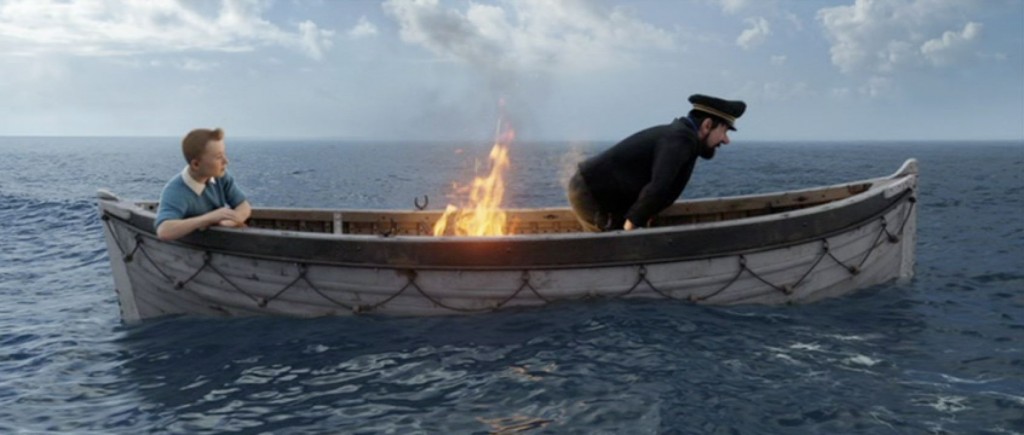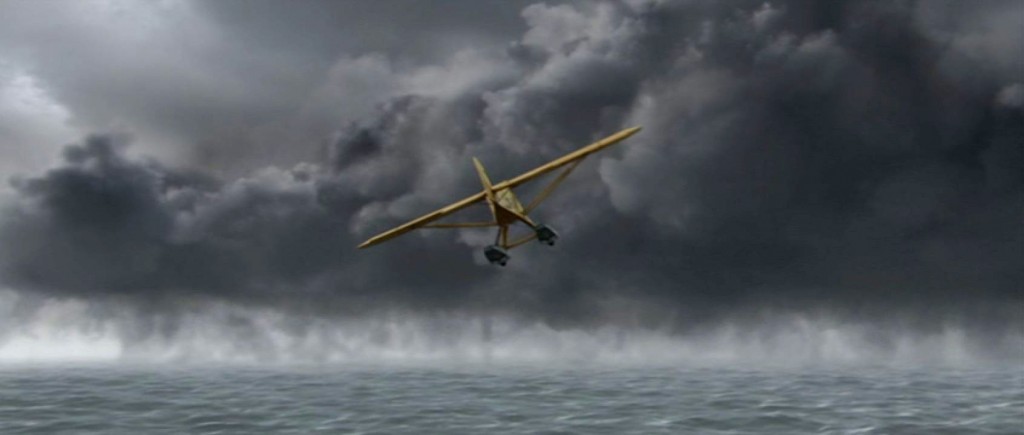Spielberg: The Adventures of Tintin part 5
Tintin and Haddock have escaped the clutches of Sakharine and are adrift at sea. Tintin takes the moment to sit Haddock down and recite “what we know so far.” There are three models of the Unicorn, therefore three scrolls hidden within them. Sakharine has one, Tintin had one but doesn’t now, and Sakharine is on his way to get the third, from a sultan in Morocco. Sakharine needs Haddock because the legend says “only a True Haddock” can solve the secret of the Unicorn. Haddock, unfortunately, cannot remember anything, due to his alcoholism. (“Legends,” and their close kins “prophecies,” are great for adventure tales. They are always right and inarguable.)
This is a classic mid-movie pivot, not quite an act break, where the plot takes stock of itself and chaos begins to settle into manageable plot. Again, because the movie is meant to welcome youngsters, the mystery is clever but not difficult to solve or even keep track of. Clues are announced and always lead to correct deductions, and if they don’t (as in the case of “Karboudjan“, which was spelt out by the dying Dawes but led to no deductions at all) the plot steps forward to render deduction unnecessary. The pivot here is that the movie begins to become about Haddock. It’s not that it’s no longer about Tintin, because Tintin is still the journalist chasing the story, it’s that Tintin’s goal now becomes “to learn the story of Haddock.” He’s now chasing a story about a story, in the same way that Spielberg is making a movie about chasing a story about a boy chasing a story within a story.
I am not a Tintin expert, but my wife is, and I have found, while analyzing The Adventures of Tintin, Tintin’s innocence and timelessness striking. My wife informs me that Tintin, as a comic, was reflexive and self-aware from the beginning, that creator Herge was, like Spielberg, intentionally using and turning over various tropes and conventions in knowing references to established forms. Spielberg was part of what they called the “film school generation” of directors who made “movie-movies,” movies, the primary points of reference of which were not human experience but quotations from other movies; Herge could then be said to be creating “adventure-adventures,” comics, the primary points of reference being other adventure stories. As a child, one experiences Tintin as pure adventure, as an adult one reads it and grins at the warm tributes to this or that form of storytelling. That is to say, The Adventures of Tintin isn’t merely an exercise in nostalgia for Spielberg, it’s that that sense of nostalgia is a correct interpretation of the source material.
As Haddock clumsily points his now-tiny crew toward Morocco, Thomson and Thompson investigate Mr. Silk, the pickpocket. Of course, Thomson and Thompson, being classic idiots, do not believe Silk is the pickpocket but instead have come to return his wallet, which they got from him in their previous encounter. Their idiocy leads Silk to confess, but still they don’t suspect him of any crimes. Nevertheless, they find Tintin’s wallet in Silk’s apartment, among his vast collection of wallets — Silk, we find, does not steal wallets for the money but for their intrinsic beauty. He claims to be not a thief but a kleptomaniac; he’s close but not quite there — what he is is a collector. His mania, like Tintin’s, like Sakharine’s, like any arrested man-boy’s, is completion and classification. In the Spielbergian tradition, which demands that the cliche be stood on its head, the arrested man-boy is, ironically, not arrested by the police.
Meanwhile, at sea, Tintin has put himself in the hands of a drunken captain, a man so lost in whiskey that he forgets that one does not light a campfire in a lifeboat, which is a man lost indeed. Haddock blames his drinking on his distant relative Sir Francis, a man so great that he casts too deep a shadow on a mortal as ordinary as Haddock. Like Sakharine and Tintin and Mr. Silk, Haddock is arrested in a moment in time, unable to move forward and unable to accept responsibility for anything. His next step after realizing the error of sabotaging the lifeboat (Haddock, you could say, has been sabotaging his lifeboat all his life) is to announce a suicide attempt, in spite of the fifteen-year-old boy (and his dog) currently in his care.
Luckily, a new transport appears, in the form of a plane, sent by Sakharine to capture Haddock. Spielberg knows that adventure is about transport, both spiritual and physical; he claims that the Indiana Jones movies intentionally involve every form of transport known to their time (and some not, like, say, gigantic flying saucers and jungle-cutting machines). It is not enough, in an adventure story, that the plot keep moving, the protagonist must also keep moving. (The plane sent by Sakharine shoots at them, which seems to contradict Sakharine’s orders to take Haddock alive, but enough.)
Tintin, with one shot, brings down the plane, damaged but intact. Now he’s a teenage boy (with a dog) and a drunken sailor, pitted against two thugs with guns and a plane. This being Tintin, he turns the tables on them without a struggle and hijacks their plane. Spielberg indulges in a Jaws reference, briefly turning Tintin’s cowlick into a shark’s fin, a rare moment of actual self-quotation, and a wise one, since Jaws created such a demand for Jaws references in the world cinema market, Jaws references are now as much a part of world culture as Treasure Island or The Maltese Falcon or The Hardy Boys or any other of the stories that Herge drew on when creating Tintin. Tintin is all about reflexivity, looking at stories through mirrors and lenses and frames, and while Spielberg directed Jaws, he no longer owns it — it has become a commonality. When he quoted Jaws in 1941 it was self-reference, but to quote Jaws in Tintin comments not on Jaws but on Jaws‘s place in the world marketplace of ideas.
Haddock politely requests that Tintin not steer the plane (which Tintin learns to fly after browsing the instruction manual) into a stormy “wall of death,” but Tintin ignores him. “We can’t turn back,” he says, his face taking on the grim tone of obsession, “not now, not now.” And yet, why not? “The Story” isn’t dependent on Tintin reaching Morocco before Sakharine, and, even if it were, he doesn’t have all the pieces, he only has Haddock. Tintin must become obsessive at this point in order to join Quint and Roy Neary and Keys and Capt Miller and Avner — Spielberg protagonists driven by an idea so consuming to them that they must pursue it regardless of the safety of others.




I wonder where the Tintin comics fall in the sequence of adventure/treasure hunting comic strips of the early/mid-20th century. This discussion was reminding me of Carl Barks’ Donald Duck and Uncle Scrooge stories that could feature globetrotting adventures. Tintin began in the 1930s and apparently Barks started doing comics in the 1940s. I’m not sure where comic strip adventures like ‘The Phantom’ or ‘Terry and the Pirates’ fit in, but they seem all of a piece.
I had very high hopes for the Tintin movie because it’s written by three of my favorite current entertainers. Stephen Moffat is the showrunner of ‘Doctor Who’ and writer of my favorite story arcs; he’s also the co-creator of ‘Sherlock.’ (Side note: Mark Gatiss, ‘Sherlock’s’ co-creator, plays Mycroft on the show.) Edgar Wright wrote and directed the insanely great ‘Sean of the Dead’ and ‘Hot Fuzz’ as well as the creatively abundant ‘Scott Pilgrim vs. the World.’ Joe Cornish, a frequent collaborator of Wright’s, wrote and directed the breezy ‘Attack the Block.’
So I went into Tintin expecting the film to deliver wittier comedy and more verbal sophistication than the finished product offers. Haddock, Thompson and Thomson tend to be bumblers, but they didn’t strike me as particularly funny bumblers like you’d find in a Pixar movie. Maybe Spielberg wanted to avoid the kind of irony and winking-at-adults that many CGI features offer.
My wife informs me that Tintin, as a comic, was reflexive and self-aware from the beginning…
With Herge, Peyo (creator of the Smurfs), and Magritte, can we say there’s something in the water in Belgian? Or maybe it’s the double consciousness of living in a bi/tri-lingual country. I mean that “double consciousness” in the way W. E. B. DuBois talks about it for African-Americans: the simultaneous being and being-other.
So Magritte is a painter, painting pre-existing paintings in odd combinations (the portrait and the fruit still-life); while Peyo is playing with language’s uncertainty with the Smurfs using “smurf”/”schtroumpf” in many different ways; and Herge puts Tintin through some adventure tropes. (The opening titles and Tintin’s office’s paper clippings nicely point up this history.)
(Although if that theory were true and bi-lingualism led to self-reflexivity, I guess we’d expect some more self-reflexive artists from Quebec. Or maybe separatism and bi-lingualism don’t mix?)
And going along with that reflection issue, Silk and Sakharine: one stays close to home, the other travels far abroad and doesn’t really have a home; one is interested in the process of adventure (stealing for his collection), the other is interested in the product (using his collection of model ships to lead him to treasure).
P.S. Do you have a plan for the next film to analyze so I can study up?
Next up is The Dark Knight Rises.